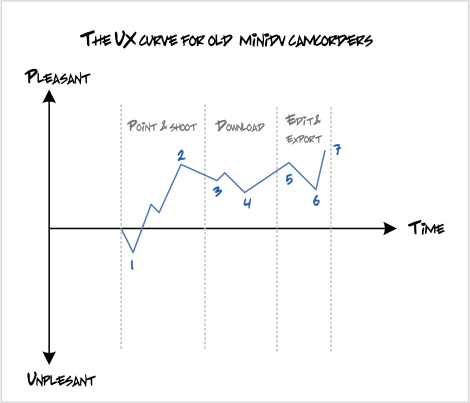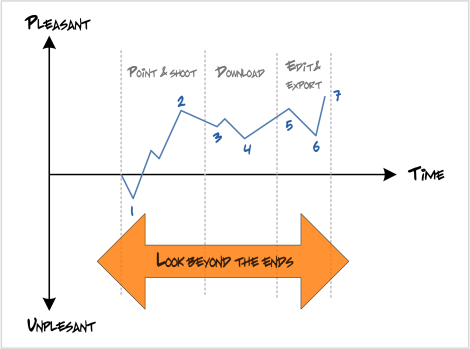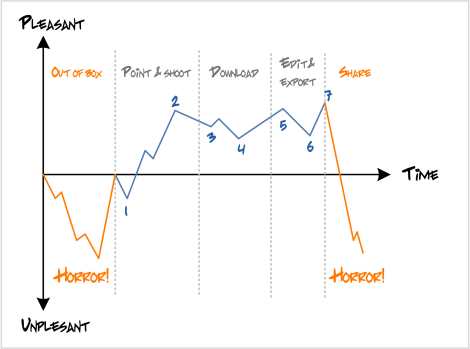When you’re designing an experience, it’s easy to look at your competition and get caught up in the normal way of doing things. Rather than being innovative, you end up creating some small incremental improvements.
A better approach can be to look beyond the conventional ends of the experience. Any human activity is usually couched inside a bigger activity, and that within another bigger activity in turn. Life, in a sense, is like Russian dolls, and sometimes being innovative involves focusing on a different layer to your competition. Here’s an example of digital video cameras and how The Flip brand cameras stormed the market. Andy Budd’s user experience curve diagram gives us a neat way of visualising them…

In the diagram above you can see the experience curve for a traditional Mini DV camera. It starts low (1) because of the faffing involved in taking out the battery, charging it separately, unwrapping the tape and and so on. Once it’s all ready to go, point and shoot (2) is pretty easy going, but when it comes to download & edit (3-6), things can get pretty annoying at times. Eventually, once you’ve completed the export process, you’re a happy bunny. Despite the negative points, you’ve ended up with some fairly high quality footage on your computer. So now lets look beyond the ends of the designed experience by extending the scope of the timeline before and after…


So what have we got here? Outside the scope of the designed experience, it’s a complete car crash. Firstly, you have to refer to the manual. You have to go out and buy some tapes. It’s tiresome and fiddly and you need a rainy afternoon alone with the camera to really get to know it. Then, at the other end, you’ve got the sharing issue. You’ve got your lovely, high resolution video file sitting on your computer but how do you get it to your friends? Up until recently, getting your footage onto YouTube wasn’t a joined-up experience. You had to know about settings and codecs and all kinds of techy stuff.
Then The Flip camera came along in 2007 and all that was history. They nailed the market with a cheaper, lower spec piece of technology – and they did it by designing beyond the conventional ends of the experience.
Your mention that human activity is usually couched inside a bigger activity, seams like Activity Theory to me :) breaking the individuals behaviour into activities, of which you break down further into actions, which are further subdivided into operations.
Don Norman is talks allot about both Activity Theory and Service Design. See both http://www.jnd.org/dn.mss/the_psychology_of_wa.html and http://www.jnd.org/dn.mss/human-centered.html
It is also worth looking at this post by Fred Wilson “Convenience Beats Quality” about qik, a Flick competitor. http://www.avc.com/a_vc/2008/06/convenience-bea.html
Wilson argues that Convenience is the driving factor. Should we start a new discipline focusing on Convenience?
Pingback: Top posts this year on on 90percentofeverything.com- 90 Percent of Everything